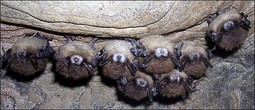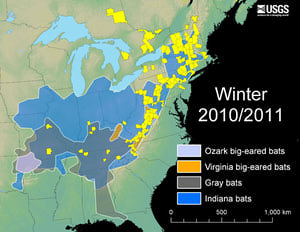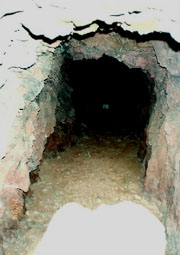White nose syndrome in bats: Difference between revisions
| Line 64: | Line 64: | ||
==Current Research== | ==Current Research== | ||
1) Experimental infection of bats with Geomyces destructans causes white-nose syndrome: This article suggests there is evidence lacking that Geomyces destructans is the primary source of white-nose syndrome. Also, Lorch et al state that many assume that all fungal infections are commonly connected with immune system dysfunction. Finally, Geomyces destructans is commonly found on European bats’ skin but there are no large bat mortality occurrences that have led scientists to believe that Geomyces destructans is not the sole cause of white-nose syndrome. | |||
2) White-nose syndrome threatens the survival of hibernating bats in North America: The USGS has compiled information concerning five species of bats: little brown bats, northern long-eared bats, Indiana bats, big brown bats, and tricolored bats. White-nose syndrome had suddenly and rapidly become widespread. Geomyces destructans has played a major role in the swift decrease in bat populations on the northeastern coast. | |||
3) White-nose syndrome: is this emerging disease a threat to European bats?: Geomyces destructans was found to affect North American bat populations starting in 2006. It was not until 2009 that Geomyces destructans was found to pose a threat in Europe. This article explains the planning of multiple countries trying to gain more information about white-nose syndrome and whether or not it will lead European bats to a similar outcome of North American bats. | |||
<br> | <br> | ||
Revision as of 04:23, 27 March 2012
Introduction
Other examples:
Bold
Italic
Subscript: H2O
Superscript: Fe3+
This template gives you a general idea of the layout of your page. You are not completely restricted to this format, so feel free to try out different things. I'll give you feedback as you work on your pages. Make sure to copy the "code" of this page to your own page before editing. -Prof Kent
In the introduction, give a brief overview of the microbial interaction that is the topic of this page. Introduce the interaction, the organisms involved, the ecological significance of this interaction, and the importance of microorganisms and their processes in this environment (described in more detail below). What processes do they carry out? What functions do they perform? Why are microbes important in this interaction?
Biological interaction
Provide details of the symbiosis or biological interaction. Is this a specific or general interaction? How do these interactions influence the host or other microbial populations, and their activities? How do these interactions influence other organisms (positive or negative influences)? What is the outcome of this interaction? Are there ecological consequences?
Describe biological interactions using as many sections/subsections as you require. Look at other topics available in MicrobeWiki. Create links where relevant.
Subsection 1
Subsection 1a
Subsection 1b
Subsection 2
Niche
Describe the physical, chemical, or spatial characteristics of the niche where we might find this interaction, using as many sections/subsections as you require. Look at other topics available in MicrobeWiki. Create links where relevant.
Caves
Subsection 1a
Subsection 1b
Abandoned Mines
Microbial processes
What microbial processes are important for this microbial interaction? Does this microbial interaction have some ecosystem-level effects? Does this interaction affect the environment in any way? Describe critical microbial processes or activities that are important in this interaction, adding sections/subsections as needed. Look at other topics in MicrobeWiki. Are some of these processes already described? Create links where relevant.
Subsection 1
Subsection 1a
Subsection 1b
Subsection 2
Key Microorganisms
What specific kinds of microbes are typically involved in this interaction? Or associated with important processes? Describe key groups (genera, species) of microbes that we find in this environment, and any special adaptations they may have evolved to survive in this environment. List examples of specific microbes that represent key groups or are associated with important processes found in this environment. Add sections/subsections as needed. Look at other microbe listings in MicrobeWiki. Are some of the groups of microbes from your environment already described? Create links to other MicrobeWiki pages where possible.
North American Bats
Subsection 1a
Subsection 1b
Geomyces destructans
Current Research
1) Experimental infection of bats with Geomyces destructans causes white-nose syndrome: This article suggests there is evidence lacking that Geomyces destructans is the primary source of white-nose syndrome. Also, Lorch et al state that many assume that all fungal infections are commonly connected with immune system dysfunction. Finally, Geomyces destructans is commonly found on European bats’ skin but there are no large bat mortality occurrences that have led scientists to believe that Geomyces destructans is not the sole cause of white-nose syndrome. 2) White-nose syndrome threatens the survival of hibernating bats in North America: The USGS has compiled information concerning five species of bats: little brown bats, northern long-eared bats, Indiana bats, big brown bats, and tricolored bats. White-nose syndrome had suddenly and rapidly become widespread. Geomyces destructans has played a major role in the swift decrease in bat populations on the northeastern coast. 3) White-nose syndrome: is this emerging disease a threat to European bats?: Geomyces destructans was found to affect North American bat populations starting in 2006. It was not until 2009 that Geomyces destructans was found to pose a threat in Europe. This article explains the planning of multiple countries trying to gain more information about white-nose syndrome and whether or not it will lead European bats to a similar outcome of North American bats.
References
Edited by Rachel Luttrell, a student of Angela Kent at the University of Illinois at Urbana-Champaign.



